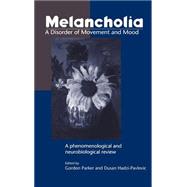
Melancholia: A Disorder of Movement and Mood: A Phenomenological and Neurobiological Review
by Edited by Gordon Parker , Dusan Hadzi-Pavlovic-

This Item Qualifies for Free Shipping!*
*Excludes marketplace orders.
Buy New
Rent Textbook
Used Textbook
We're Sorry
Sold Out
eTextbook
We're Sorry
Not Available
How Marketplace Works:
- This item is offered by an independent seller and not shipped from our warehouse
- Item details like edition and cover design may differ from our description; see seller's comments before ordering.
- Sellers much confirm and ship within two business days; otherwise, the order will be cancelled and refunded.
- Marketplace purchases cannot be returned to eCampus.com. Contact the seller directly for inquiries; if no response within two days, contact customer service.
- Additional shipping costs apply to Marketplace purchases. Review shipping costs at checkout.
Summary
Table of Contents
| Introduction | |
| Classification and research: Historical and theoretical aspects | |
| 1. Issues in classification: Part I. Some Historical Aspects: 2. Issues in classification: Part II. Classifying Melancholia: 3. Issues in classification | |
| Part III. Utilizing Behavioral Constructs in Melancholia Research: 4. Issues in classification: Part IV. Some Statistical Aspects: Development and Validation of a Measure of Psychomotor Retardation as a Marker of Melancholia: 5. Psychomotor change as a feature of depressive disorders: historical overview and current assessment strategies | |
| 6. Development and structure of the CORE system | |
| 7. Reliability of the CORE measure | |
| 8. Validity of the CORE: Part I. A Neuroendocrinological Strategy: 9. Validity of the CORE: Part II. Neuropsychological Tests: 10. Validity of the CORE | |
| Part III. Outcome and Treatment Prediction: 11. Phenotypic expression of melancholia contrasted for those with bipolar and unipolar illness courses | |
| 12. Psychotic depression: clinical definition, status and the relevance of psychomotor disturbance to its definition | |
| 13. A clinical algorithm for defining melancholia: comparison with other sub-typing measures | |
| 14. Rating the CORE: a user's guide | |
| The Neurobiology of Melancholia: 15. Melancholia as a neurological disorder | |
| 16. Melancholia and the aging brain | |
| 17. Magnetic resonance imaging in primary and secondary depression | |
| 18. Functional neuroimaging in affective disorders | |
| 19. Summary and conclusions | |
| Appendix | |
| The CORE measure: procedural recommendations and rating guidelines | |
| Bibliography. |
An electronic version of this book is available through VitalSource.
This book is viewable on PC, Mac, iPhone, iPad, iPod Touch, and most smartphones.
By purchasing, you will be able to view this book online, as well as download it, for the chosen number of days.
Digital License
You are licensing a digital product for a set duration. Durations are set forth in the product description, with "Lifetime" typically meaning five (5) years of online access and permanent download to a supported device. All licenses are non-transferable.
More details can be found here.
A downloadable version of this book is available through the eCampus Reader or compatible Adobe readers.
Applications are available on iOS, Android, PC, Mac, and Windows Mobile platforms.
Please view the compatibility matrix prior to purchase.